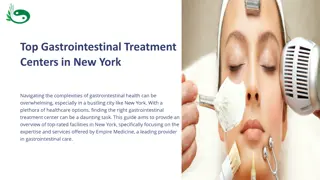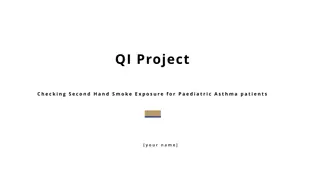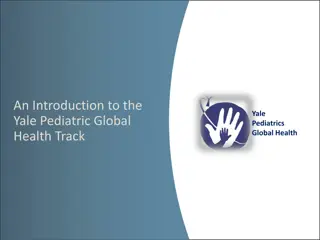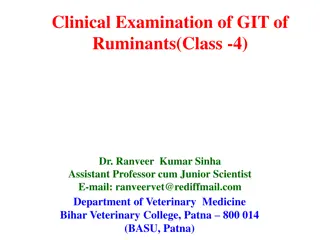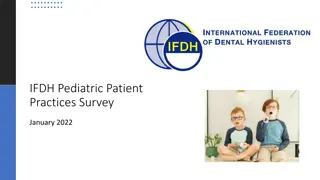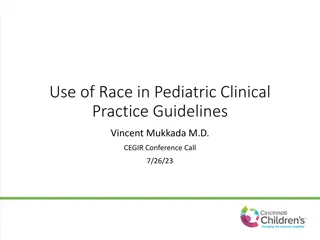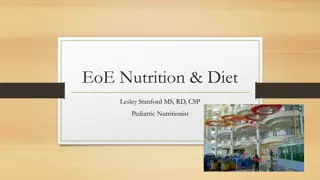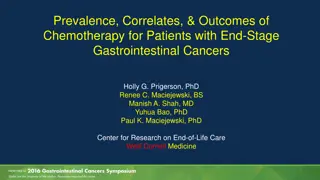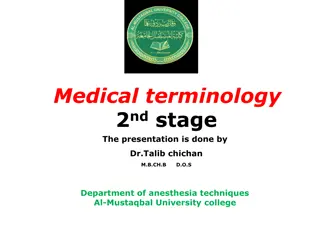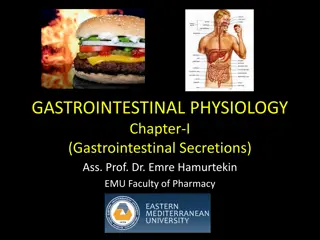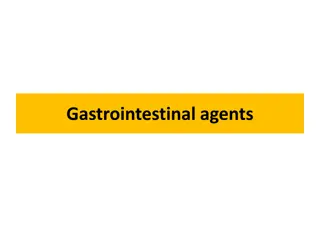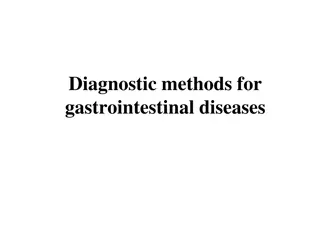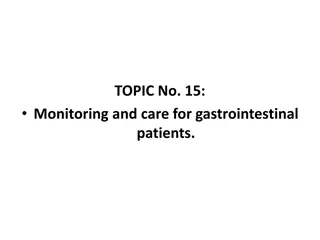Understanding Eosinophilic Gastrointestinal Diseases in Pediatric Patients
This educational material covers the clinical presentation, causes, allergic histopathology, immunopathogenesis, and management options for pediatric patients with eosinophilic esophagitis (EoE). Expert insights are provided on defining EoE, discussing etiology, diagnosing EoE, demographics, and the natural history if left untreated. The content highlights the chronic, immune/antigen-mediated nature of EoE characterized by eosinophil-predominant inflammation in the esophagus. Various triggers, allergic responses, and lymphocyte interactions are explained, along with dietary and medical management strategies.
- Pediatric patients
- Eosinophilic Gastrointestinal Diseases
- EoE
- Allergic Histopathology
- Immunopathogenesis
Download Presentation

Please find below an Image/Link to download the presentation.
The content on the website is provided AS IS for your information and personal use only. It may not be sold, licensed, or shared on other websites without obtaining consent from the author. Download presentation by click this link. If you encounter any issues during the download, it is possible that the publisher has removed the file from their server.
E N D
Presentation Transcript
Faculty Disclosures Research Support Shire, Regeneron, Allakos, AstraZeneca, Danone clinical area: eosinophilic gastrointestinal diseases Consultant Shire, Regeneron, Allakos, Adare, AstraZeneca clinical area: eosinophilic gastrointestinal diseases Speaking Fees Nutricia, Medscape, Vindico clinical area: eosinophilic gastrointestinal diseases
Learning Objectives Recognize the clinical presentation of EoE in infants, toddlers, children and teenagers Explore various dietary and medical management options for pediatric patients with EoE
Module 1 Define EoE Discuss etiology Review immunopathogenesis
EoE: Definition Chronic, immune/antigen-mediated esophageal disease is characterized by Clinically: Symptoms related to esophageal dysfunction Histologically: Eosinophil-predominant inflammation Liacouras et al, J Allergy Clin Immunol 2011
EoE: Causes EoE triggers Food allergens Environmental allergens Liacouras et al, J Allergy Clin Immunol 2011
EoE: Allergic Histopathology Allergen exposure Allergic inflammatory response Infiltration of the esophagus with eosinophils and other inflammatory cells Activated eosinophils Mast cells Eosinophils CD4 lymphocytes CD8 lymphocytes Dendritic cells Chehade, Gastrointest Endosc Clin N Am 2008
EoE: Allergic Th2 Lymphocytes normal GERD EoE 90 Allergic Th2 milieu 80 IL-4 IL-13 IL-5 70 Cells x 103/mm3 60 50 40 30 20 10 0 CD3 CD4 CD8 CD20 T lymphocytes B lymphocytes Lucendo et al, Am J Surg Pathol 2007 Blanchard et al, J Allergy Clin Immunol 2007
EoE: Immunopathogenesis Ko and Chehade, Clin Rev Allergy Immunol 2018 Used by permission from Springer Nature
Module 2 Demographics of EoE How to diagnose EoE EoE natural history, if untreated
EoE: Demographics Age Can occur at all ages Race More frequently reported in whites Racial minorities likely underdiagnosed Gender More common in males (M:F ratio ~3:1) Comorbidities More common in patients with food allergy More common in patients with atopic diseases Familial history Family history of EoE Family history of atopic diseases Genetics and shared environment effects Liacouras et al, J Allergy Clin Immunol 2011 Jensen et al, J Pediatr Gastroenerol Nutr 2013 Chehade et al, J Allergy Clin Immunol Pract 2018
EoE: Symptoms Vary With Age 90 80 70 Adults (n=74) 60 % patients 50 Children (n=21) 40 30 20 10 0 Chehade et al, J Pediatr Gastroenterol Nutr 2007 Gonsalves et al, Gastrointest Endosc 2006
EoE in Children: Comparison of All Symptoms n=793 476 adults 317 children 0-2 years 3-10 years 11-17 years 70 60 Percent of children 50 40 30 20 10 0 Vomiting Growth failure Food refusal Moawad Chehade, Clin Gastroenterol Hepatol 2016
EoE in Children: Comparison of All Symptoms 0-2 years 3-10 years 11-17 years n=793 476 adults 317 children 60 50 Percent of children 40 30 20 10 0 Dysphagia Food impaction Heartburn Moawad Chehade, Clin Gastroenterol Hepatol 2016
EoE: Challenges in Clinical Presentation Nonspecific gastrointestinal symptoms look for: Early satiety Failure to thrive Personal or family history of food allergy Personal or family history of atopy History of allergic gastrointestinal symptoms in infancy Subtle symptoms (due to feeding compensatory behaviors) look for: Taking too long to finish a meal Prolonged chewing Pocketing food in the mouth Needing to drink with every bite of food Cutting food into very small pieces Lubricating tough/lumpy foods with condiments/dunking in liquids Avoiding tough/lumpy foods altogether Food refusal altogether
EoE: Endoscopic Diagnosis Plaques Furrows Stricture Rings
EoE: Endoscopic Diagnosis normal Endoscopy can be normal in up to 20% of patients Biopsies important regardless of the endoscopic findings
EoE: Histological Diagnosis Normal (0 eos/HPF) EoE ( 15 eos/HPF) PATCHY DISEASE eos/hpf, eosinophils per high-power field
EoE: Histological Diagnosis Eosinophil superficial layering and microabscesses Eosinophilic degranulation
EoE: Diagnosis per 2011 Guidelines - Symptoms - Esophageal eosinophilia - Proton pump inhibitor therapy, to rule out PPI- responsive esophageal eosinophilia (PPI-REE) Liacouras et al, J Allergy Clin Immunol 2011
PPI-REE: Vast Similarities With EoE PPI-REE and EoE indistinguishable clinically, endoscopically, and histologically PPI: anti-inflammatory effect on esophageal epithelial cells in vitro Adults with PPI-REE: responded to dietary elimination therapy Dellon et al, Am J Gastroenterol 2013 Moawad et al, Aliment Pharmacol Ther 2014 Cheng et al, Gut 2013 Sodikoff et al, J Allergy Clin Immunol 2016 Lucendo et al, J Allergy Clin Immunol 2016
Updated 2018 EoE Diagnostic Algorithm Clinical presentation suggestive of EoE Upper endoscopy with biopsies Esophageal eosinophilia ( 15 eosinophils/HPF) Evaluate for non-EoE disorders that cause or potentially contribute to esophageal eosinophilia Eosinophilic esophagitis Dellon et al, Gastroenterology 2018
EoE: Natural History EoE is a chronic disease EoE may progress: inflammation-predominant fibrosis- predominant
EoE: Course With Increasing Age North Carolina, 2013 Retrospective 379 children and adults Eosinophilic esophagitis is a progressive fibrostenotic disease Dellon et al, Gastrointest Endosc 2013 Used by permission from Elsevier
EoE: Course With Increasing Duration of Symptoms Schoepfer et al, Gastroenterology 2013
EoE: Inflammatory Phenotype Furrows Plaques Plaques along furrows Seen more often in early disease Seen more often in children
EoE: Fibrostenotic Phenotype Stricture Rings Seen more often in late disease Seen more often in adults
Pediatric EoE: Fibrosis can be reversed with diet or topical corticosteroids EoE Patient Pre-treatment EoE Patient Post-treatment Trichrome stain Lieberman Chehade, Allergy 2012 Used by permission from John Wiley and Sons
Conclusion: Diagnosis and Natural History of EoE EoE diagnosis is based on clinical, endoscopic, and histological criteria. Symptoms can be nonspecific in children with EoE. If left untreated, EoE can lead to fibrostenotic complications.
Module 3 Treatment options Dietary restriction therapies Medications
EoE: Therapy Endpoints Reduce symptoms and esophageal inflammation Reverse existing disease complications Prevent future complications
EoE: Commonly Used Therapies Dietary restriction therapies Topical corticosteroid therapies Dilation of esophageal strictures
EoE: Dietary Therapies Elemental diet Amino acid-based formula Amino acid-based formula + 1-2 foods (modified elemental diet) Test-directed elimination diet Based on results of skin tests (prick and patch) Empiric elimination diet Removal of common food triggers without testing
EoE: Histological remission with elemental diet Children: 90%, Adults: 94% Arias et al, Gastroenterology 2014
EoE: Histological remission with test-directed diet Children: 48%, Adults: 32% Arias et al, Gastroenterology 2014
EoE: Histological remission 6-food elimination diet Children: 73%, Adults: 71% Arias et al, Gastroenterology 2014
EoE in Children: Common Food Triggers 36 children were rechallenged with foods: 80 70 60 % disease relapse 50 40 30 20 10 0 Milk Wheat Egg Soy Peanut Seafood Kagalwalla et al, J Pediatr Gastroenterol Nutr 2011
Pediatric EoE: Empiric Elimination Diet (4-FED) 78 children Foods removed: milk, wheat, egg, soy 4-FED for 8 weeks 64% Remission (<15 eos/HPF) Sequential reintroduction of foods, followed by biopsies; triggers identified: Milk 85% Wheat 33% Egg 35% Soy 19% Kagalwalla Chehade, Clin Gastroenterol Hepatol 2017
EoE: Empiric Elimination Diet Remission rate (%) (children) 73 64 43 ? 6-FED 4-FED 2-FED 1-FED Arias et al, Gastroenterology 2014 Kagalwalla Chehade, Clin Gastroenterol Hepatol 2017 Molina-Infante et al, J Allergy Clin Immunol 2017
EoE: Current Diets Under Study in Children 1-FED versus 4-FED: Elimination of milk VERSUS milk, wheat, egg, soy (ClinicalTrials.gov NCT02610816)
Dietary Restrictions Pros Some diets are highly effective Allow potential identification of food triggers Prevent need for chronic medications, with their potential side effects May reduce systemic inflammation (vs local effect of medications) Cons Require a large effort by the patient and family for implementation Most diets require availability of a specialized dietitian Multiple endoscopies needed to identify the food trigger Not effective when environmental allergens trigger EoE Chehade and Sher, Allergy Asthma Proc 2017
EoE: Which children should get dietary therapy? Patients are selected based on a discussion with the family. Multiple factors are considered before opting for dietary therapy and choosing type of dietary therapy: Age Nutritional status Feeding difficulties Self-restrictive behaviors towards foods Social settings Motivation of patient and family Social support system Financial support system Acceptance of multiple endoscopies Chehade and Brown, Expert Rev Clin Immunol 2020
EoE: Nutritional Management in Practice Work Group Report of AAAAI 2017 for dietary therapy implementation: Assess nutritional status Eliminate dietary antigens Individualize to meet nutritional needs Give practical tips on substitutions Provide monitoring Groetch Chehade, J Allergy Clin Immunol Pract 2017
EoE: Dietary Therapy as Maintenance Therapy? Diets can be gradually liberalized over time, reintroducing foods that do not trigger EoE. Challenges with food introductions: Difficulty identifying safe foods (mostly trial and error) Rare chance of de novo acuteallergic reactivity SPT/serum food- IgE level (by an allergist) may be needed before food reintroduction Ho and Chehade, J Allergy Clin Immunol Pract 2018 SPT, skin-prick test
EoE: Commonly Used Food Challenge Algorithm Food challenge (6-8 weeks) EGD + biopsies EoE relapse Continued remission Eliminate food again Keep food in the diet EGD, Esophagogastroduodenoscopy
Conclusion: Dietary Therapy for EoE Dietary therapy can be effective. It is optimal for eligible and motivated patients. Ongoing support is needed for its success.
EoE: Histological remission with proton pump inhibitors Children: 54%, Adults: 50% Lucendo et al, Clin Gastroenterol Hepatol 2016




